Top 10 baits from Smith Lake
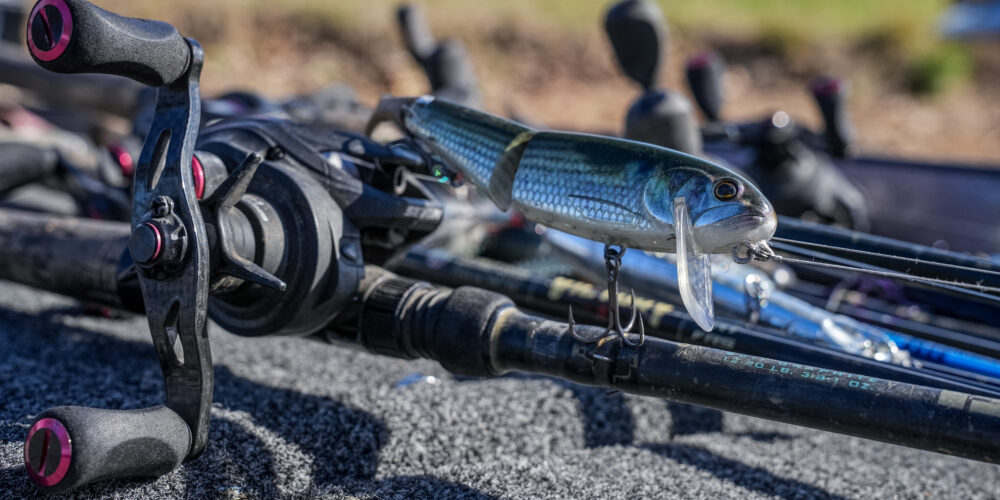
CULLMAN, Ala. – The second event of the Toyota Series Presented by Phoenix Boats Central Division season saw impressive numbers of fish caught at Smith Lake of both the largemouth and spotted bass varieties. A fishery loaded with both, it was no surprise to see nearly 41 pounds as the cutoff to make the Top 10.
While most of the field leaned on spotted bass to fill out limits and hoped to land on the right ones to jump up the leaderboard, largemouth certainly played a huge role in the event – especially for winner Rusty Cooper, who weighed in nothing but largemouth over three days en route to a 20-pound, 14-ounce Day 3 and a 6-4 margin of victory.
Here’s a closer look at how the Top 10 anglers caught their fish at Smith.
1. Cooper leans on one area, one tackle company for the win
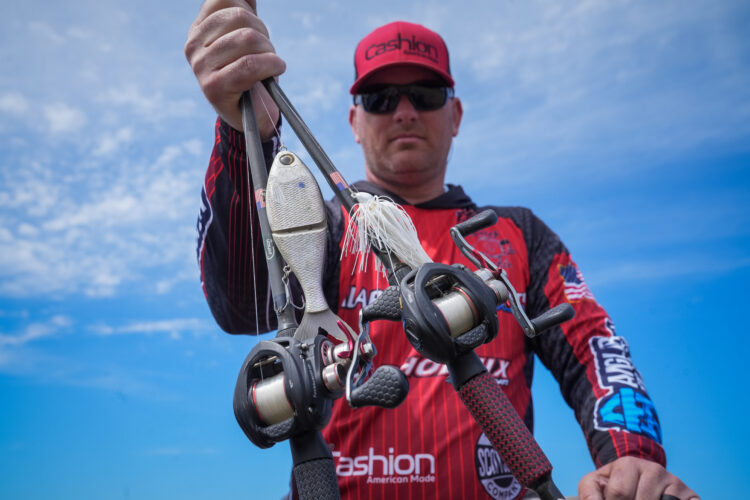
Cooper didn’t have a great practice, but he did manage to catch a couple nice largemouth in a pocket that he then decided to make his home for the next three days. There, he weighed in over 16 pounds on Day 1 and eventually worked on the largest bag of the event – by far – on the final day.
On the first two days, smaller presentations – a wacky-rigged Xcite Baits stickbait and a Scottsboro swim jig with a Reaction Innovations Skinny Dipper trailer – were big players, but after Cooper stumbled on Day 2 (13-5 on just four fish), he knew he needed to go big or go home without a trophy.
“I just put the big baits in my hand today and said I’m going to go for it,” he explained. “I need a big bag. I’m either going to catch them or I’m not.”
He did, in fact, catch them. Using a 4- and 6-inch Scottsboro swimbait and a Scottsboro glide bait, Cooper opted for big presentations for big fish and has $95,500 to show for it.
2. Wiggins’ one-two punch
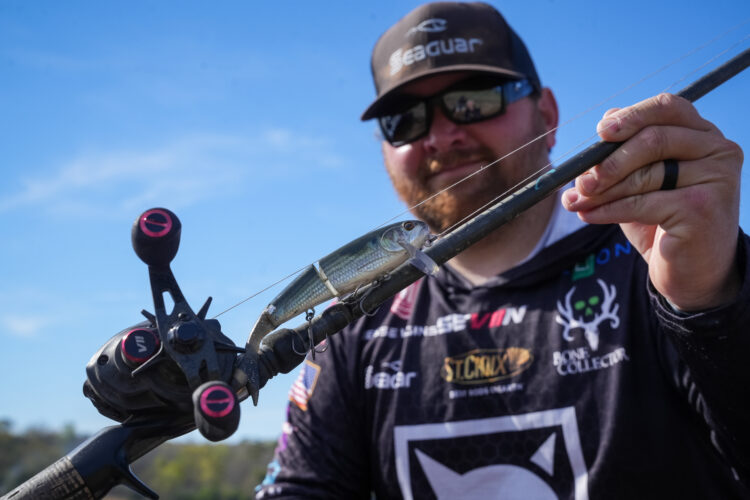
Bass Pro Tour pro Jesse Wiggins has a ton of experience on Smith Lake – and has found a ton of success as a touring professional in general – so it came as no surprise to see him finish runner-up to Cooper.
Looking for areas he’s historically found spotted bass chasing blueback herring, Wiggins put a 7-foot, 1-inch medium-heavy St. Croix Legend Elite spinning rod in his hand and paired it with a SEVIIN spinning reel with 20-pound-test Seaguar Smackdown braid and a 12-pound-test Seaguar Tatsu leader. To the end of the leader he tied a 3/16-ounce shaky head with a Jackall Flick Shake 5.8 in green pumpkin pepper.
After leaning on the shaky head on Day 1, he found continued success with a bigger bait with a ton of drawing power.
“I caught a bunch on a shaky head on the first day, and then the last day I caught them on a Jackall Blast Bone Jr.,” he said. “It kind of acts like a glide bait because it goes barely under the surface, but it has a bill like a wake bait.”
To throw the glide/wake hybrid, Wiggins used a 7-foot, 3-inch medium-heavy St. Croix Victory rod with a SEVIIN reel (6.6:1 gear ratio) spooled with 40-pound-test Smackdown.
3. Swindle moves with his spots
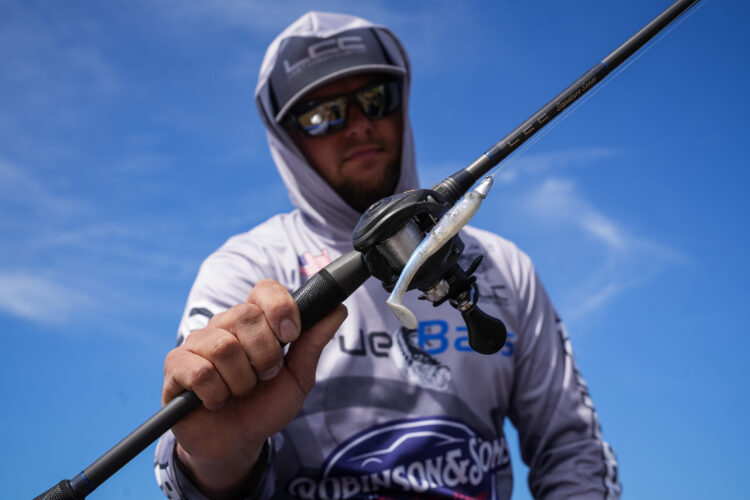
Going into the event, Austin Swindle expected areas with a lot of larger-than-average spawning spotted bass to be key to a top finish. On Day 1, he found some of those areas and went to work to the tune of 15 pounds.
While those fish were up on the bank on Day 1, Swindle had to make a major adjustment on Day 2 to relocate his fish.
“Pretty much staying close to the areas I know they spawn (was key),” he said. “They pull off and they’ll either sit right off the first main ledge – or if the bait comes through, they’ll pull off and chase them.”
That’s what Swindle did on Day 2, moving slightly away from the bank and switching from a Neko-rigged stickbait to a 4-inch True Bass swimbait on a 3/8-ounce True Bass jighead to catch those spotted bass that were more free-roaming away from the shoreline.
4. All about the points for Gordon
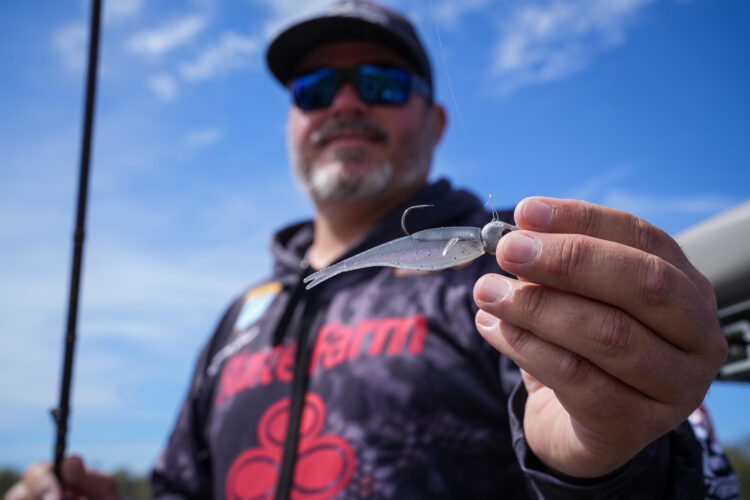
After finishing eighth at Smith Lake last year primarily fishing shallow, Jeremy Gordon tried his hand at the shallow game in practice to find it just wasn’t going to be the deal. Instead, he went to offshore points – specifically, long, tapering points holding schools of herring. There, he found masses of spotted bass and went to work.
“I went through probably 40 or 50 fish a day and slowly culled up,” he said.
After running points at the upper end of the lake, Gordon made a key Day 2 move to a section near the dam with more long points, culling up late in the day on Day 2 and setting up shop in that area all of Day 3.
To catch his fish, Gordon went with a duo of a V&M Vertical Shad and a Strike King Baby Z-Too. For heads, he used a hand-poured 3/8-ounce head as well as an Angler Tungsten Eclipse jighead. For his rod and reel setup, Gordon used Powell Endurance rods and Shimano Stradic Ci4 reels spooled with Seaguar Smackdown braid (10-pound test) and a Seaguar Tatsu leader (8-pound).
And, as you might expect with an offshore spotted bass pattern, Gordon relied heavily on his Garmin LiveScope for identifying schools of bait and bass, as well as some key solo spots where he found his biggest – and toughest-to-catch – keepers for the week.
5. Davis keeps it simple
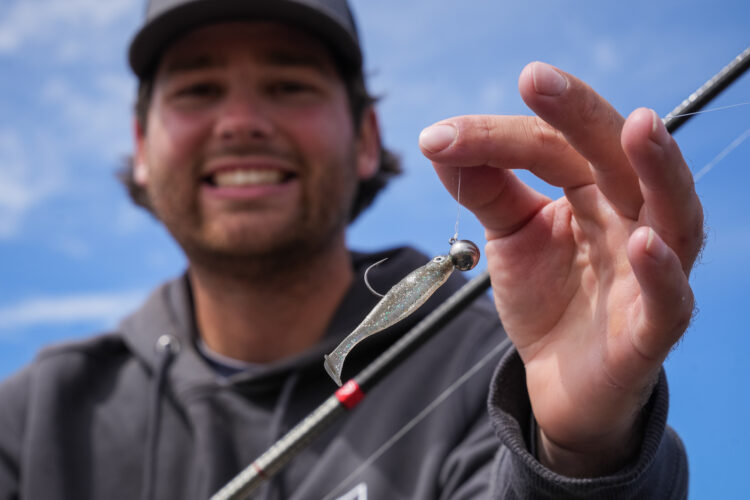
Figuring the bass were between spawning waves and not right up on the bank, Flint Davis went to likely spawning areas, pulled back from the bank and dropped down his LiveScope to find schools of spotted bass either waiting to move up to spawn on having already pulled off.
“I would just get off those banks and LiveScope around until I found them,” he said. “I just focused on catching as many as possible each day. I was targeting spotted bass. The best way to catch 13-plus pounds a day is to catch as many as possible. You can’t focus on getting only six or seven bites a day.”
Once he located his fish, Davis wielded a 7-foot, 1-inch Favorite Sick Stick rigged with a Keitech Swing Impact FAT 2.8 or a 3-inch Megabass Hazedong Shad on a 1/4-ounce Dirty Jigs Guppy Head.
Davis said opting for a more traditional paddle-tail swimbait over the hot new pintails and fluke-style mini-swimbaits seemed to make a difference of a few bites a day – enough to make his sixth MLF Top 10.
6. Peavyhouse sticks to ‘Scoping
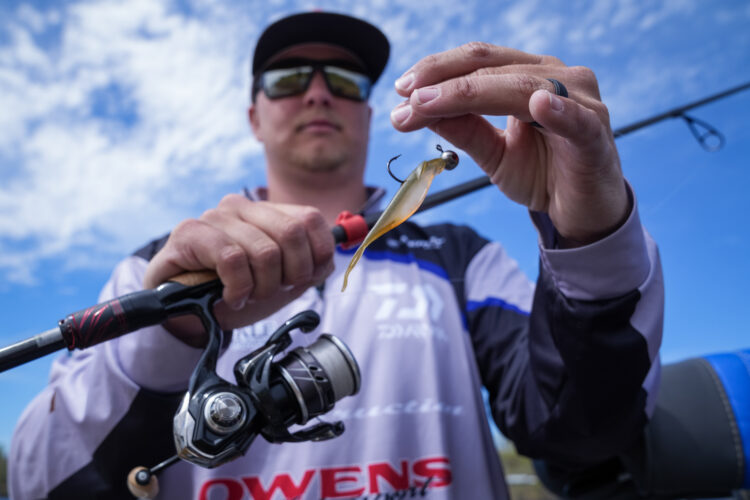
After finding the bed fish he marked in practice mostly gone on Day 1 of the tournament, Isaac Peavyhouse opted for his backup plan of ‘Scoping for spots. Plan B worked well enough for a sixth-place finish, thanks in part to his patterning of those schools.
“I spent all day ‘Scoping, fishing around main-lake points, the mouths of pockets and some main-lake docks,” he said. “Just running around looking for schools. It had to be a steeper bank. Most of them were out roaming, either singles or in little wolfpacks. I think most of them were prespawn. They were still pretty fat.”
Apart from a 3-pound largemouth he caught off a bed on Day 1, Peavyhouse leaned on those spotted bass with either a 1/4- or 3/8-ounce Torrent Outdoors jighead of his design tipped with a Strike King Baby Z-Too or a Deps Sakamata Shad (Wakasagi) tied to a Daiwa J-Fluoro Samurai fluorocarbon leader on a Daiwa J-Braid main line. His rod and reel of choice were Daiwa Steez rods (7-foot medium) and Daiwa Tatula MQ LT reels.
7. Bed fishing fizzles for Howell
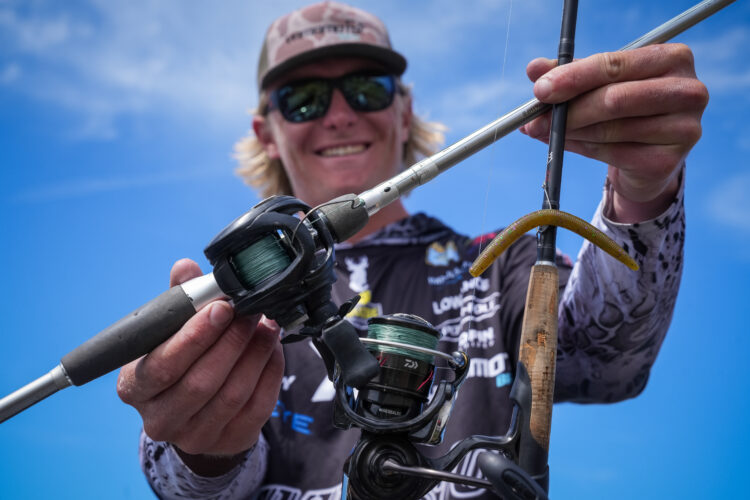
Laker Howell grabbed the Day 1 lead by way of a handful of quality bedding largemouth he marked during practice. Unfortunately for Howell, as the weather continued turning colder and that wave of bass began moving off the bank, he just ran out of bedders to target and had to go to his backup plan of ‘Scoping spots most of Days 2 and 3.
“Day 1, I ran around and chased [bedding largemouth] all day,” he said. “That was the whole plan. I really wanted to try to swing for a win on that one, but they kind of ran out.”
Howell’s bed fishing setup is a unique one. Apart from using a wacky-rigged Yamamoto Senko (5-inch, green pumpkin purple copper) on a Daiwa KAGE 7-foot medium rod paired with a Daiwa KAGE MQ LT spinning reel (3000 size), he used a power approach consisting of a 7-foot, 6-inch Daiwa KAGE flipping stick paired with a Daiwa Tatula 100 casting reel spooled with straight 70-pound-test Daiwa Samurai braid. At the business end – the most important part for Howell – is a white, 1/4-ounce Texoma Tackle tungsten weight, which he uses as a visual cue for bed fishing so he’s able to throw natural colors for his bait.
After catching four largemouth off beds on Day 2, Howell needed to turn to Plan B and fill out his limit with Lowrance ActiveTarget 2 forward-facing sonar. For that, he used a Yamamoto Scope Shad.
“In practice, I had checked this one spot – I guide there in the offseason so I’m familiar with certain places they group up,” he said. “This one spot I didn’t think they were going to be. I ran into it in practice just to check it and I found one wad of fish that had 20-plus spots. I came back the last day and I found the biggest school of spots I’ve ever seen in my life.”
Despite the size of the school, it broke into pods, and Howell was only able to catch about a dozen throughout the day.
8. Knies runs three distinct programs
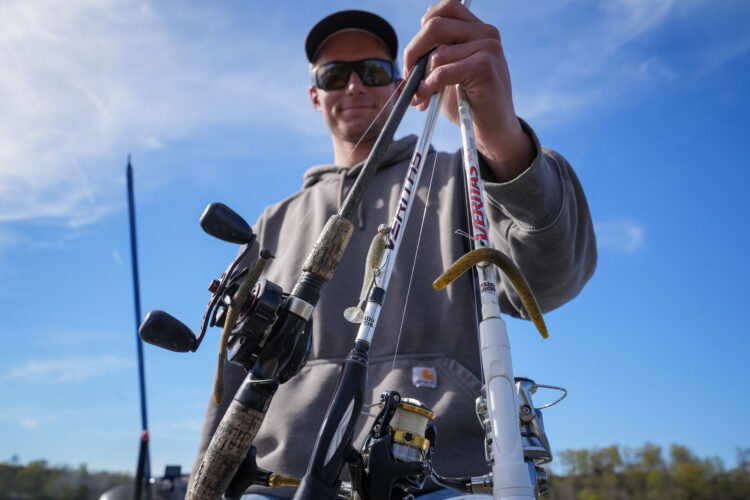
On Day 1, Blake Knies weighed in a 16-pound, 2-ounce bag anchored by largemouth. But, as was the case for many others at Smith, that bite went away on Day 2. Knies called an audible and did some LiveScoping for spotted bass to weigh in 13-9 and went back to that approach on Day 3 before going back to the bank in search of spawning spotted bass.
For his Day 1 largemouth, Knies opted for a weightless approach with a tried-and-true Smith Lake staple: a wacky rig consisting of a 5-inch green pumpkin Yamamoto Senko.
“Basically, Day 1, I just threw a wacky rig around any dock or whatever else toward the back of those pockets, and that’s how I caught the bigger ones staging up,” he said. “A lot of them looked like they were postspawn. Some of them were prespawn.
“Day 2, when that wasn’t working, I had to go LiveScope points and some pockets – areas where I knew I had fish.”
For his wacky rig setup, Knies purchased a new rod and reel just for Smith and just for that technique: a 7-foot, medium Abu Garcia Veritas rod and Shimano NASCI reel.
For ‘Scoping, Knies tried the Damiki rig game but found he had more success with a 2.8-inch Keitech Swing Impact FAT on a 1/4-ounce head. And on Day 3, for his spotted bass bank fishing, he employed a 3/16-ounce shaky head with a green pumpkin Berkley PowerBait MaxScent Hit Worm.
9. McCormick ‘Scopes near the dam
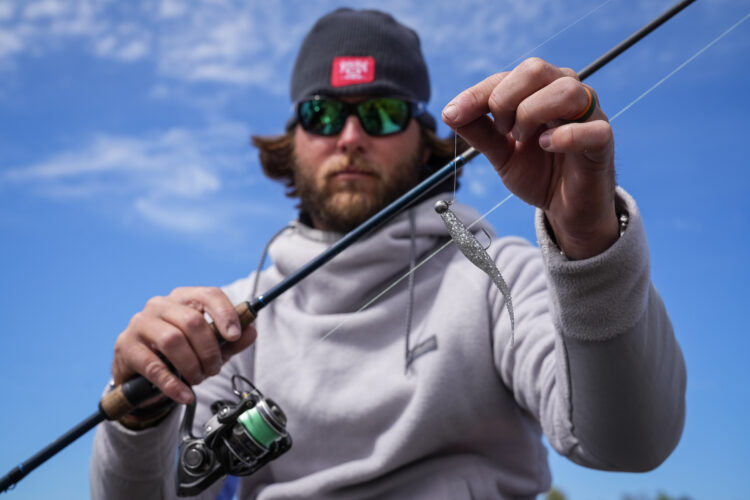
Find the bait, find the bass. Find the big bait, find the big bass.
At least that was Tristan McCormick’s approach to Smith Lake in securing his Top-10 finish. McCormick spent his time within a few miles of the dam, where he posits most of the lake’s herring – and, therefore, biggest spots – roam around.
“The biggest thing with Smith is finding the bait,” he said. “There’s threadfin and herring. The bigger spots are going to be on that herring, and all that herring’s going to be within three miles of the dam. That’s where I focused my time – two or three miles each way of the dam. At about every lake, the biggest fish in the lake live around the dam.”
McCormick committed to LiveScoping all three days, and while he struggled to work his schools because of the wind on Day 1, he figured something out on Day 2 to catch his 15-5.
“The biggest deal was to match the hatch, and I caught several fish out of those schools choking up 4-inch herring,” he said. “I was catching them on a Mach Skooler. I was catching them on a [Strike King] Baby Z-Too and a regular Z-Too.
“I caught a 3-pounder and it spit up a giant herring, so I dug into my box and got a big Z-Too, and the first drop I caught one almost 4 pounds. The bigger baits produced the bigger bites.”
For rigging his swimbaits, McCormick went with a few different sizes and styles of jigheads, including a hand-poured head, a 1/4-ounce Owner Range Roller for spots suspended high in the water column and a Queen Tackle 1/2-ounce head for deep bites in 55 to 60 feet of water.
10. Local knowledge plays for Sams
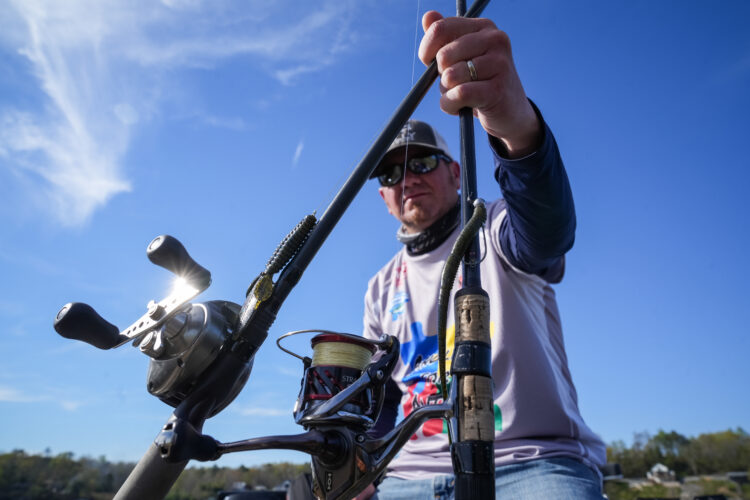
Being a local of Smith Lake (and having finished third in the Toyota Series event there in 2023), Wesley Sams knows more than a little about how the lake’s bass population moves around – and where the largemouth like to set up shop.
“I found a few spawning largemouth and I would throw a Sweet Beaver at them,” he said. “Being a local, I just know where they tend to spawn. I wasn’t necessarily looking at every fish I caught. Most of them I was blind casting around areas. I wasn’t sight fishing, per se, but I was fishing for spawning largemouth.”
The spawning largemouth deal was half Sams’ program – almost literally, considering seven of the 15 fish he weighed in were largemouth. Before he targeted largemouth each day, though, he filled out his limit on spawning spotted bass, again in areas where he knew they’d probably be. That turned out to be slightly off the bank in deeper water.
Sams’ flipping setup for targeting spawning largemouth consisted of the aforementioned Reaction Innovations Sweet Beaver on a 5/0 Owner hook with a 1/2-ounce tungsten weight. That was tied to 25-pound-test Seaguar Red Label fluorocarbon spooled on a Shimano Curado 200 paired with a 7-foot, 5-inch, heavy G. Loomis NRX.
To go after spots, Sams went with a 7-foot, 3-inch, medium-heavy G. Loomis GLX and a Shimano Stradic Ci4 with 15-pound-test braid and a 15-pound-test Red Label leader. He tied on a 3/16-ounce homemade shaky head with a 6-inch Reaction Innovations Flirt Worm (green pumpkin).